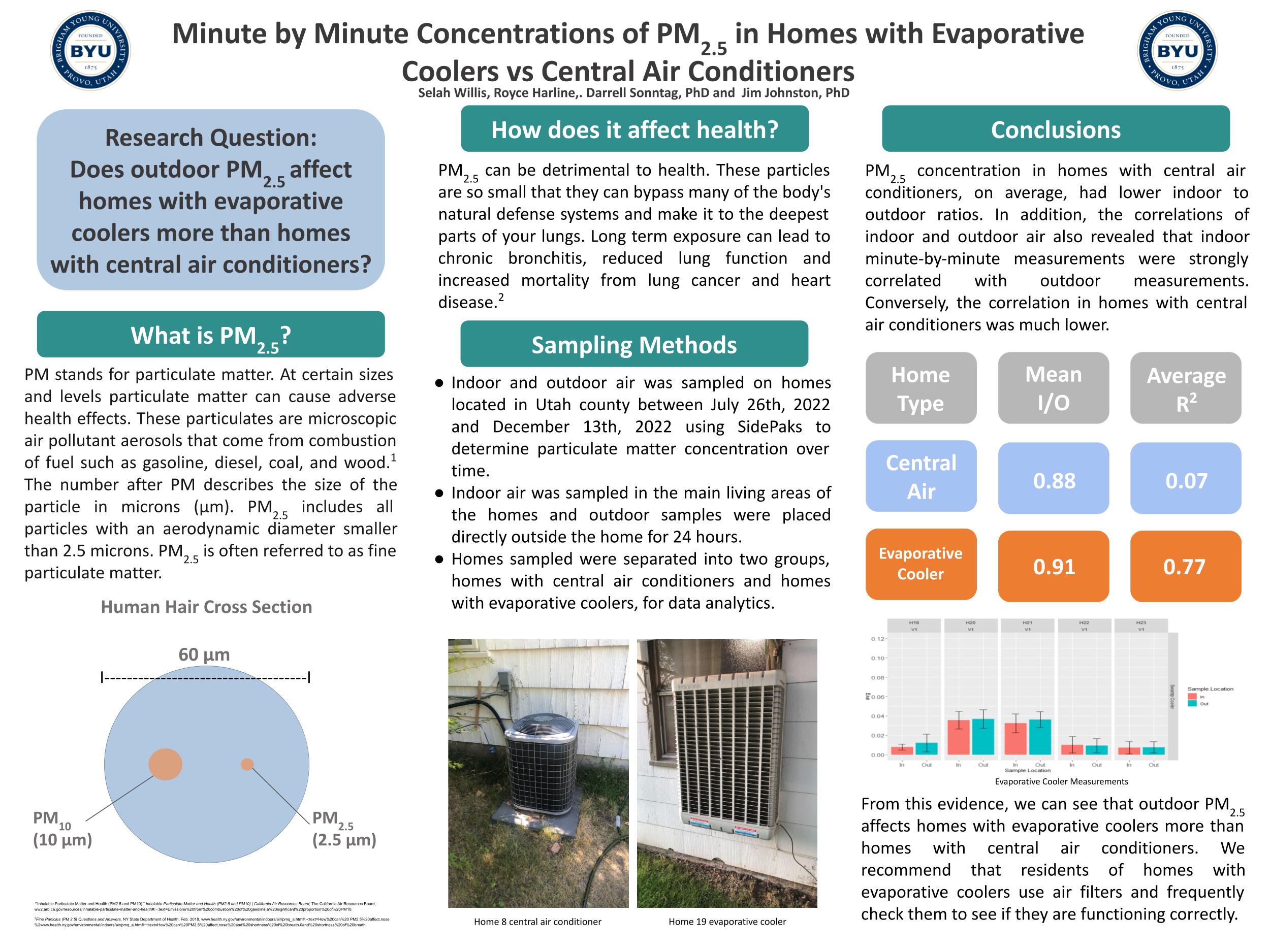Presenter Name: Selah Willis
Additional Presenters:
Pablo Harline (rpharline@gmail.com)
Description
Evaporative Coolers (swamp coolers) function by passing outdoor air over a water-saturated pad. The pad water then evaporates, cooling the air before it is directed into the home. Central air conditioning cools the home using recirculated indoor air. In this study, we explore and compare the quantity of fine particulate matter (PM2.5) that enters a home being cooled by a swamp cooler versus central air conditioning. PM2.5 is dangerous to the human respiratory system and is linked to lung cancer, chronic obstructive pulmonary disease, and asthma.
Using an Optical Particle Counter (OPC), we collected the PM2.5 concentrations every minute over a 24-hour period in 15 central air and 7 swamp cooler homes as well as outdoor PM2.5 concentrations at the same locations. All measurements were done from June-September 2022 in Utah County. All participants were asked to behave as they normally would with the exception of any activities that produce indoor particulate matter (cooking, vacuuming, vaping, etc.).
Using the uncorrected photometer data, the ratio of indoor to outdoor (I/O) revealed significant differences between the PM2.5 concentration of homes with different types of air conditioners. Central air homes had an average I/O at 0.64, and standard deviation of 0.45. Swamp cooler homes, on the other hand, had an average I/O 0.90 and standard deviation of 0.18. These results meet our expectations due to the mechanical properties of each type of air conditioner: Swamp coolers bring in outdoor air, and central air systems filter and recirculate indoor air with less outdoor air infiltration. We are in the process of further analyzing the minute-by-minute data to discover any meaningful temporal patterns.
The study confirms previous research that residents of swamp cooler homes will be exposed to higher levels of PM2.5. Our findings were corroborated by 24-hour PM2.5 filter samples collected alongside the OPC readings. By examining hours with high levels of exposure, we hope to recommend interventions to decrease exposure to PM2.5 in swamp cooler homes.
Using an Optical Particle Counter (OPC), we collected the PM2.5 concentrations every minute over a 24-hour period in 15 central air and 7 swamp cooler homes as well as outdoor PM2.5 concentrations at the same locations. All measurements were done from June-September 2022 in Utah County. All participants were asked to behave as they normally would with the exception of any activities that produce indoor particulate matter (cooking, vacuuming, vaping, etc.).
Using the uncorrected photometer data, the ratio of indoor to outdoor (I/O) revealed significant differences between the PM2.5 concentration of homes with different types of air conditioners. Central air homes had an average I/O at 0.64, and standard deviation of 0.45. Swamp cooler homes, on the other hand, had an average I/O 0.90 and standard deviation of 0.18. These results meet our expectations due to the mechanical properties of each type of air conditioner: Swamp coolers bring in outdoor air, and central air systems filter and recirculate indoor air with less outdoor air infiltration. We are in the process of further analyzing the minute-by-minute data to discover any meaningful temporal patterns.
The study confirms previous research that residents of swamp cooler homes will be exposed to higher levels of PM2.5. Our findings were corroborated by 24-hour PM2.5 filter samples collected alongside the OPC readings. By examining hours with high levels of exposure, we hope to recommend interventions to decrease exposure to PM2.5 in swamp cooler homes.
University / Institution: Brigham Young University
Type: Poster
Format: In Person
Presentation #D43
SESSION D (3:30-5:00PM)
Area of Research: Health & Medicine
Email: selah.willis99@gmail.com
Faculty Mentor: James Johnston

